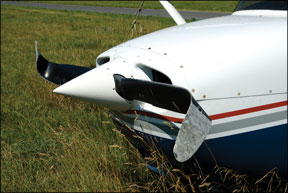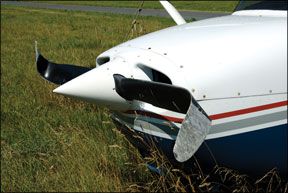The left engine was cutting out but youve kept it running with the aux pump. Weather at the big airport, 15 miles from your destination, has been dropping slowly; its down to 500 feet overcast and a mile visibility, which just happens to be the published minimums for both of the approaches into Homeplate Regional, where you base your light twin.
The couple in the back seat had been fighting about him drinking vodka from the bottle for the first hour of the trip, but once he passed out, things quieted down. Just as ATC gives you the clearance for a lower altitude, the rains intensity goes from light to firehose and the left engine again demands attention. Full rich mixture smooths it out. A moment later the remaining conscious passenger in the back seat

288
announces her water has broken and shes in labor.
Your right seat passenger asks if youre going to declare an emergency and shoot the ILS into the big airport.
“No way,” you reply, visions of John Wayne, Chuck Yeager and The Right Stuff in your mind as you turn to focus your steely, glinting baby blues on him. “Im not filling out all that paperwork; Ill just make sure were number one for the approach into Homeplate.”
Over the next 10 minutes the mother-to-be in the rear seat makes increasingly vocal announcements regarding contractions at regular and diminishing intervals, and when you make a power reduction as you near the final approach fix the left engine resumes its misbehavior.
The engine responds to your ministrations by quitting altogether. You go through the drill, verify, feather and pull its mixture to idle cutoff. You manage to get things more or less collected and pretty much on the final approach course over the next minute when ATC calls to clear you for the approach and ask that you cancel IFR with them or on the ground by telephone. You swallow, summon up your best airline pilot voice and reply with the last three digits of your N-number.
At the final approach fix, you select gear down. Nothing happens. Then you remember the hydraulic pump is on the left engine, so you extend the hand pump handle, begin pumping and feel the airplane slow as the gear starts down.
Reading the instruments is difficult when bent over to reach the pump handle, and you become curious about the odd way they are starting to glow. About then someone yells, “Were on fire!”
The NTSB report stated the pilots at Homeplate Regional heard the airplane approach, saw a glow in the fog and then observed the airplane almost directly overhead at about 200 feet. They saw it enter a steep left turn. Flames were trailing from the left wing. The airplane then descended rapidly, striking the ground in a steep nose-down attitude. There were no survivors.
Post-crash examination of the fuel system was inconclusive but a crack in a fuel line forward of the firewall was believed to have preexisted the crash and may have been the cause of the in-flight fire, although the pilot gave no indication to ATC of any difficulties. While the left mixture control was at idle cutoff the left fuel selector was set to the left main tank and the aux fuel pump switch was positioned to “on,” which would have caused fuel to continue flowing through the cracked line.
Yes, the foregoing is fiction. But accidents like the one described happen with great regularity and for no good reason.
I Aint Declarin
Those who emerge from human society and go through the rigors and accept the risks of becoming pilots tend to be self-reliant. They are problem solvers. They recognize that each flight will have its share of things to go wrong, and solving them on their own is part of the challenge to be enjoyed. To many, asking for help is to admit a personal shortcoming. Therefore, to declare an emergency is to admit to all the world-at least that portion of it listening on the radio-that they are wanting in some way, that they dont have the Right Stuff. They abide by the time-honored principle of the needlessly deceased, “Its better to be dead than embarrassed.”
The reality is that the very best pilot is one who knows what resources are available to solve the problems encountered in flight and to call on them as needed. For the vast majority of all flights, the appropriate resources are in the airplane, its systems and avionics, with some limited need for reaching outside via radio calls for the purpose of getting weather updates and talking with ATC or CTAF to avoid hitting other airplanes.
It is those rare flights when something goes wrong that require the pilot to call upon and manage external resources. The problem is those resources generally cannot be brought into play until and unless the pilot communicates to let it be known they are needed.
In an emergency, too many general aviation pilots refuse to communicate. As a result, they cannot marshal resources available to them, too often with ugly consequences. Bluntly, they shut up and die.
The airlines and the military fought this behavior on the part of their pilots for years. It took detailed direction in checklists, threats and finally some public punishment of offending pilots to finally get them to overcome their reluctance (fear?) to declare an emergency.
Now, when an airliner or military aircraft has an engine failure and the crew pulls up the appropriate emergency checklist, they also tell ATC that they are dealing with an emergency. Instantly the crew has more tools available to help them get their passengers back to the planet alive, be it the ability to go to the front of the line for an approach or having professional firefighters and EMS personnel waiting right beside the runway for their arrival.
Paperwork?
Unfortunately, other than for corporate aircraft whose crews take regular recurrent training and some sharp Part 135 operators, the willingness to open the door to get at all the tools available for a successful culmination of a flight by declaring an emergency has not trickled down to general aviation. Its worth repeating: Too many of us shut up and die.
We GA pilots get macho at the worst possible time. We smell fuel in the cabin and just tell ATC that were returning to land, disclosing nothing more. When the airplane catches fire on final or rollout, the CFR crews are still cutting the grass rather than ready for action and once they do arrive, they have no idea how much fuel is on the airplane or how many people they need to search for and rescue.
We foolishly repeat the myth there is paperwork to fill out if we declare an emergency. This simply isnt true. The myth is the product of B-grade movies and it just keeps killing people. There is no paperwork to fill out if you declare an emergency. None. Zip. Nada. The FAA got smart on that subject long ago. The last two times I declared an emergency the nearest thing to paperwork I had to deal with was giving my name to the CFR chief once safely on the ramp, the opportunity for which I was grateful.
The only time the FAA can even ask that a pilot fill out any paperwork following an emergency is if the pilot violated one of the FARs in dealing with the emergency. First, deviating from or violating a reg in dealing with an emergency is pretty unusual. Second, the pilot only has to write it up if, and only if, the FAA asks (FAR 91.3). In 30 years of representing pilots, I have only once seen the FAA ask for a report from a pilot. And when they got the report, they took no enforcement action against the pilot.
Declaring an emergency will not get a pilot into trouble unless s/he created the emergency by doing something stupid. Even then, the obligation of the pilot is to make use of every resource available to get the passengers on the ground safely.
What it means
Declaring an emergency means getting people involved who may have information, skills or equipment that will allow the flight to be completed safely when otherwise that outcome is questionable. For example, the smell of fuel or smoke in the cabin means something is seriously wrong and its time to terminate the flight as soon as practical. Doing otherwise means betting the passengers lives that the cause of this particular odor isnt serious. Its a sucker bet. The correct reaction is figuring out the closest suitable airport, heading for it and getting crash, fire and rescue folks on the way just in case the bet comes up snake eyes and the airplane is on fire or it catches fire.
Calling ATC and letting them know about the emergency you are facing does nothing but good things for you and your passengers. Controllers can help you find the closest airport and can help you monitor your progress toward it, something that may become very important if you have to divert your attention from navigation to fight a fire. If you are headed for a towered field, ATC will have the trucks waiting for you. And, believe it or not, the CFR crews like the drill-it gets them off the lawn mowers and out doing what they signed up to do.
If you are headed for a non-towered airport, ATC will get on the phone to local authorities and get help on the way to the airport.
Frankly, we in general aviation do not have a particularly good record in handling emergencies, mostly because we dont take much recurrent training and dont practice them, so, statistically, there is an unfortunately good chance that we will not keep the airplane in one large, attractive chunk when we land. Because of that, the speed at which EMS can get to us may well be crucial. Having them on the way because we were smart enough to declare the emergency can well be the difference between surviving and a closed-casket funeral.
The truly good pilot, the one with the right stuff, lays ego aside when the fecal material hits the rotating blades, and takes whatever action is needed to get at every resource available to allow that pilot to complete the flight successfully.
Which kind of pilot are you?
Rick Durden is a practicing aviation attorney and type-rated ATP/CFI with more than 7000 hours.




